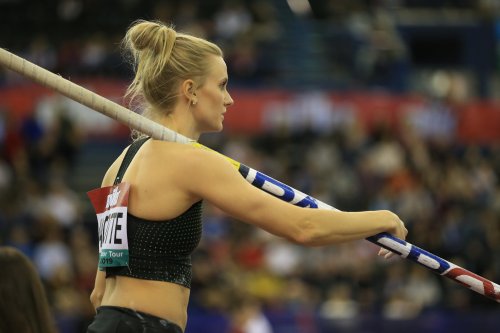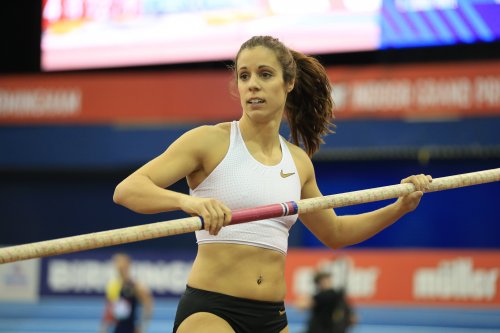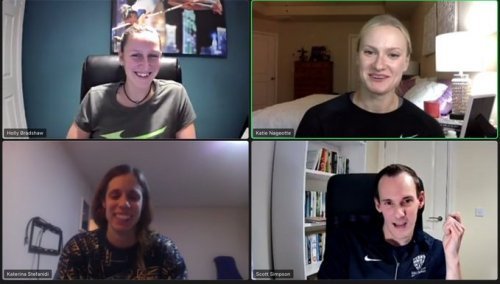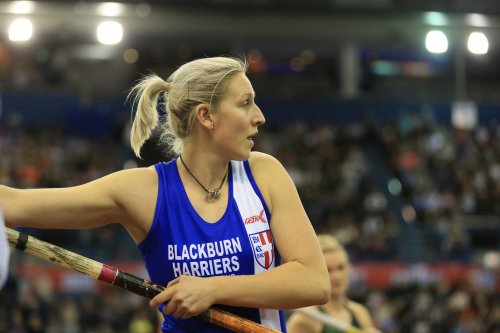The Pole Vault Seminar: Holly Bradshaw, Katie Nageotte, Katerina Stefanidi, hosted by GB coach Scott Simpson
RelatedPosts
Special thanks to Stuart Weir on including these Pole Vault Webinars on @runblogrun. This one is called Me & My Coach: Katerina Stefanidi, Holly Bradshaw and Katie Nageotte speak about their coaches.
Me and My coach
Another topic discussed in the recent webinar put on by English Athletics, moderated by Scott Simpson, GB National Performance Institute Senior Coach, and featuring Katerina Stefanidi, Holly Bradshaw and Katie Nageotte, was how the relationship between athlete and coach worked and what they were working on. Holly Bradshaw was banned from answering the question as Scott is her coach – and in his words “Holly might say something I don’t want to hear!”
 Katie Nageotte, photo by Getty Images / British Athletics
Katie Nageotte, photo by Getty Images / British Athletics
Katie is coached by Brad Walker (2007 World champion pole-vaulter). She explained how they work together: “I always had to be in control of my sessions. Coaches were great at building my confidence, telling me that I was great. And I needed that at the time. Brad is really tough. He holds me accountable to getting it done but he’s not mean. If I get yelled at, I cry. He’s very good at holding me accountable when we’re making changes and not letting me go back to old habits. He pushes me but makes it safe and explains why we’re doing it. So any changes that I made, I felt comfortable, as far as I could, doing it. He has this ability to make a change but so that it still seems like me. In the past making changes felt difficult.
“When I first came to Brad he moved my starting position on the runway up, closer to the pit by three or four feet which was a huge distance. I was fast but I was feeling too far away so I was leaning back, reaching out and slowing down into the take-off. I was forcing myself to get to the mark by reaching but I wasn’t running through the take-off aggressively. In 2018 when I jumped 4.91 that was really the first time I was running through the take-off even though I was way under, bottom arm collapsed but the intention to carry my speed through it made such a difference.
“One of my cues last year was keeping the pole tip up – which I’m not perfect at. Keeping it up until four steps out and then it’s freefall, which keeps my posture tall throughout the entire thing. I’ve had a tendency to let it get low too early and therefore I tend to lean back to balance out the weight in front of me as opposed to just charging through. I do notice when it’s a better pole drop that it is a better run and jump. I have a tendency to drive out of the back, way too hard. When I try too hard and am spinning my wheels, colleagues say, that I’m out of control so I really focus on those first two steps, thinking about it as covering ground but staying relaxed, covering as much ground with each step as I can so that it’s still powerful without trying too hard. Once I get through that then it’s just jumping up and forward through takeoff, thinking about moving my hands as quickly as I can. We have worked a lot on plant drills. I keep my hand on my hip until that second last step and then it comes up to the shoulder and up on one. When I hit the second last step it’s moving my hand up as fast and as aggressively as I can towards the crossbar and jumping up through it”.
 Katerina Stefanidi, photo by Getty Images / British Athletics
Katerina Stefanidi, photo by Getty Images / British Athletics
Katerina liked her coach, Mitchell Krier, so much that she married him! She explains: “When we started, we said ‘when we get in the car to go to practice, we are coach and athlete. When we get back in the car afterwards we are husband and wife again’. I think we’ve done quite a good job of following that. Since 2015, our lives have changed drastically with becoming part of the pole vault community and travelling. That means that is almost impossible for us not to talk about pole-vaulting at home. But I think we definitely do it in a way which is different from coach/athlete. Once in a while we will argue about something – but nothing big really.
It helps that he is my husband. He can read me. If I think of previous coaches some read me better than others read. If we’re making a big decision during the competition Mitch will look at my reaction and may decide to change what he was going to say”.
She explained one aspect of her practice that worked well for her: “I take a lot of jumps. I run less than most pole-vaulters but I’d take more jumps. I would much rather do that, and have the feeling of the pole and all the different positions where you can hit it a little different but still finish it and make it – for me, that’s a lot more important. The track and running has been there since I was a little kid and I feel that I don’t need to be working with long runs to get that consistency. If I can be consistent with 6 or 12 steps then going back to 16 just feels like adding a flying start. Indoors we never go back to my full run up. Outdoors we have done some training from the full run up but only a couple of weeks before a big meet or championship. That is partly because I take a lot of jumps.
“We’re trying to push the grip a little bit but that can create inconsistency. Consistency wins medals. It has been a battle of pushing the boundaries a little without losing the consistency”.
Holly Badshaw, photo by Getty Images / British Athletics
Holly Bradshaw talked about the importance of run-up as something she was always working on: “The run is always a priority for me and still is at the moment. I’m thinking about being tall at takeoff and keeping my left leg straight and that seems to help me to roll up and get back over the pole. I’m thinking about eight strong bouncy steps and in the last six steps I attack. I try to keep my hips up and when I’ve turned the gas on, then take off. In a good jump I’m at one with the pole all the time, transfer and speed onto it
“The challenge I haven’t the moment is deciding whether I want to do 16 or 14. In 2010-14 I was of 16 steps. I’ve used 14 for the last two years. I know that from 14 steps I can do a good consistent run and attack will. 16 is less consistent so the question is: do I want to stick with 14 which is more consistent but I’m realistic and I probably can’t jump 4.90 from 14 steps”.
Holly also explained why she starts her run-up walking! “It was something I tried when I was really struggling with my Achilles. I tried it to see if I could do a gradual walk in instead of an aggressive push off. It has been really good and helping to overcome that aggressive start. That is the only reason”.
You can watch the webinar videos on https://athleticshub.co.uk
England Athletics twitter – @EnglandAthletic
England Athletics Jumps twitter – @Englandjumps1
Scott Simpson – @Scott_Simpson_
Author

Since 2015, Stuart Weir has written for RunBlogRun. He attends about 20 events a year including all most global championships and Diamond Leagues. He enjoys finding the quirky and obscure story.
View all posts






















